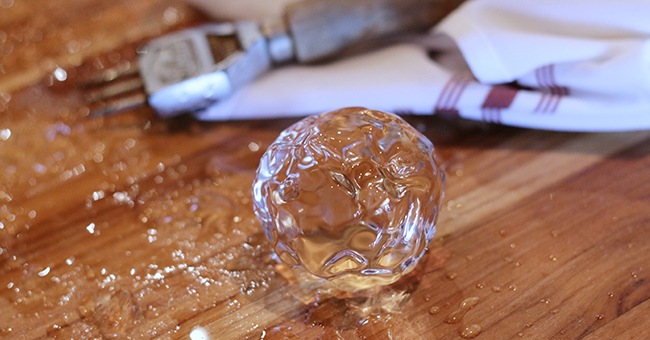Craft bars all over the world use block ice to elevate the quality of their cocktails. Large cubes and spheres have less surface area than many small ice cubes, so they offer less dilution. And when you’re sipping a fine scotch or enjoying a craft cocktail, a slower dilution rate can make all the difference.
Some craft bars make their own block ice, while others buy directly from commercial facilities. Either way, working with block ice can be a challenge, especially under pressure. In my two years working behind the bar at Atlanta’s Cibo e Beve, I’ve spent a lot of time handling block ice, since we cut our own every shift. Here are a few tips and tricks I’ve picked up along the way.
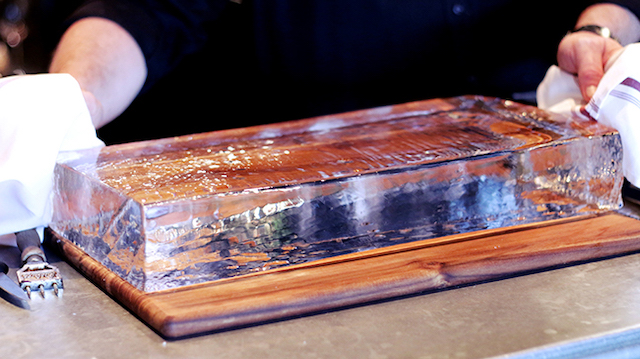 Tempering ice means allowing it to reach room temperature, and this makes it exponentially easier to cut.
Tempering ice means allowing it to reach room temperature, and this makes it exponentially easier to cut.
1. Temper, temper, temper
Tempering the ice before you attempt to cut it is the most important aspect of working with block ice. When the ice comes out of a standard freezer, it will be cloudy on the outside, like a cold beer glass. Tempering the ice means allowing it to adjust to room temperature. When the ice is fully tempered, it will be completely clear on every side, having melted its outer layer. Depending on the size of the block, tempering times will vary. The longer the ice tempers, the easier it will be to work with. As a general rule, I wait to cut into the ice until it has tempered for at least 30 minutes.
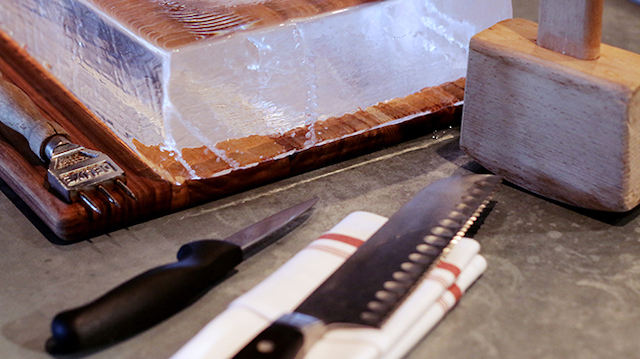 To carve craft ice, you’ll need a large serrated knife, an ice pick, a mallet, a large cutting board, a sharp paring knife and a linen.
To carve craft ice, you’ll need a large serrated knife, an ice pick, a mallet, a large cutting board, a sharp paring knife and a linen.
2. Use the right tools
It’s important to choose the proper tools when working with large ice. I typically work with a large serrated knife, an ice pick, a mallet, a large cutting board, a sharp paring knife and a linen. You can also use a large knife without serration, though I find that a jagged edge works best. There are several varieties of ice picks you can use for cutting ice; I recommend working with whichever type you feel most comfortable with.
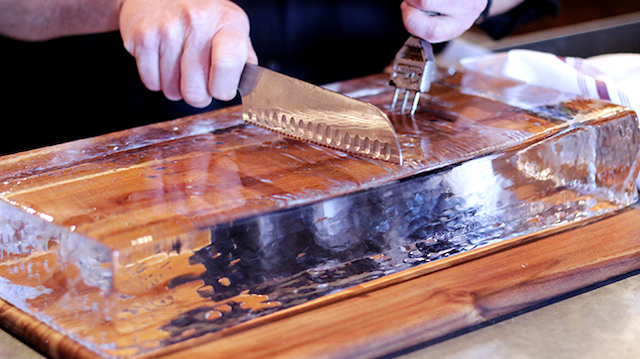 Cutting block ice from the middle will always results in cleaner cuts and less fracturing.
Cutting block ice from the middle will always results in cleaner cuts and less fracturing.
3. Cut from the center
Place your tempered block onto the cutting board or onto any surface where the ice will not slide. Using your ice pick to hold the ice in place, use your knife to gently saw a line across the center of the block ice. If your ice is rectangular, you should saw widthwise; if your ice is square, saw a line across the middle. Essentially you’re marking the ice in order to cut it cleanly in half. No matter the size or shape of your ice block, cutting from the middle will always result in cleaner cuts and less fracturing.
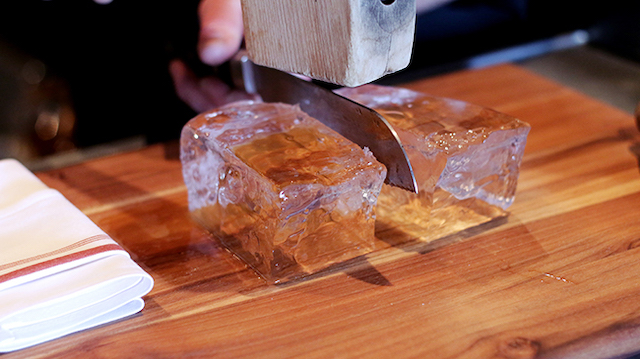 The physicality of cutting craft ice, in particular the hammering part, can become quite therapeutic.
The physicality of cutting craft ice, in particular the hammering part, can become quite therapeutic.
4. Hammer time
Holding the knife firmly along the line you marked, tap the top of the knife with your mallet. If your ice is properly tempered, it will split cleanly in half. It may take a few taps to transfer the cut to the bottom of the ice, but you can see the split as it happens. Once you’ve cut all the way through, take one of the halves and continue this process. Saw a line through the center and then tap your knife with your mallet. You can continue until you have a collection of small cubes or you can use this method to create several manageable chunks that you can cut in hand on the fly.
If your ice is not properly tempered, you might see some splintering, which is pretty normal. If that happens, let the ice temper for another five minutes and try again. If it still gives you trouble, switch to your ice pick and stab the ice along the saw mark until the ice splits. It won’t be as clean a cut as the knife and mallet method, but it will split the ice without worsening the fractures.
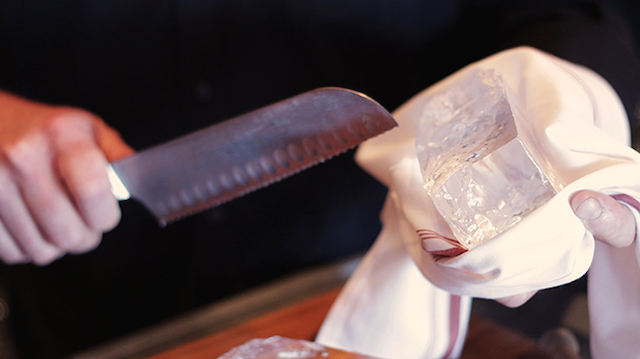 Cutting ice in hand is an easy way to start a conversation or to enliven the show of cocktail crafting.
Cutting ice in hand is an easy way to start a conversation or to enliven the show of cocktail crafting.
5. Cut in hand
Guests love to see me cut ice in hand. It’s an easy way to start a conversation or to enliven the show of cocktail crafting, but it can also be a bit dangerous, so use caution. I typically put a linen over my hand when I hold the ice, which protects my fingers and keeps the ice from slipping. Hold the chunk firmly between your thumb and middle fingers, using your other fingers as added support. Saw the line down the middle of the chunk and around the edges. Use your knife to smack the ice exactly on the cut line. It can take a few hits to cut all of the way through, but it will usually split pretty immediately.
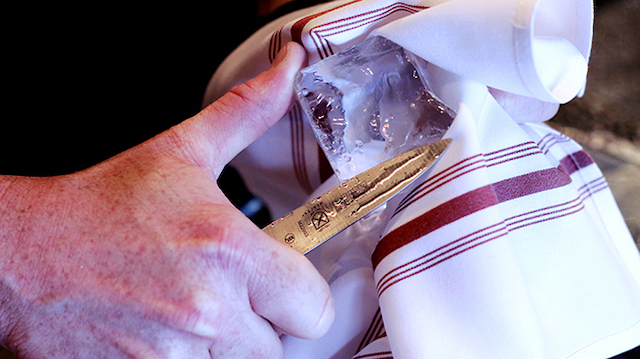 Block ice is very temperamental, and it’s not at all abnormal if you have to correct some mistakes as you go. Take your time and be patient!
Block ice is very temperamental, and it’s not at all abnormal if you have to correct some mistakes as you go. Take your time and be patient!
6. Fix imperfections
Block ice is very temperamental, so don’t be discouraged if it takes some time to get your method down. The ice may splinter and fracture for different reasons. It happens, and there are fixes when it does. Perhaps some of your cuts resulted in odd shapes. You can use a paring knife to shave off edges and imperfections. I recommend using a linen to hold the ice while pulling the paring knife up through any surface to smooth it out. Use your thumb to guide the knife, almost like cutting an orange peel.
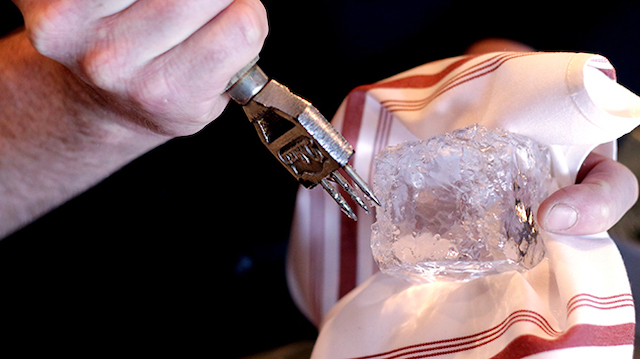 Hand-cut ice spheres and other shapes require a practiced, steady hand, and when done right, they are gorgeous additions to well-crafted cocktails.
Hand-cut ice spheres and other shapes require a practiced, steady hand, and when done right, they are gorgeous additions to well-crafted cocktails.
7. Round it out
Hand-cut ice spheres and other shapes are the next level of craft ice. They require a practiced, steady hand, and when done right, they are gorgeous additions to well-crafted cocktails. You can start with a square cube or with any shape chunk. For spheres, use your ice pick to remove any corners or protrusions from the ice. Gently carve off the edges while moving the sphere around in your hand. Using a linen is highly recommended, as spheres are even more difficult to handle than cubes. When your desired shape is achieved, rinse the sphere under some cold water to get a smoother, shinier finish.
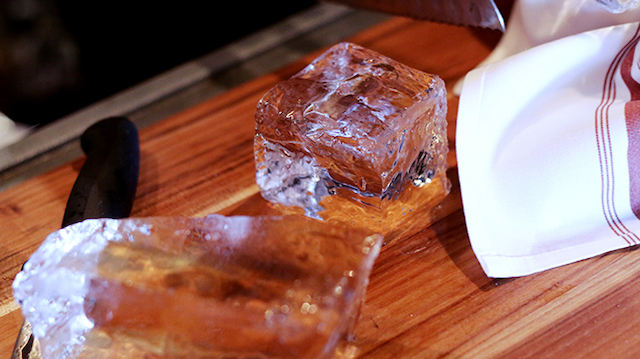 As with anything, practice makes perfect — give yourself the time and patience to master the craft of cutting block ice.
As with anything, practice makes perfect — give yourself the time and patience to master the craft of cutting block ice.
8. Practice
As with all things, practice makes perfect. The more you work with block ice, the better you will become. It takes time and patience, especially because ice can be difficult to work with, but it can also be deeply therapeutic during a busy shift.


